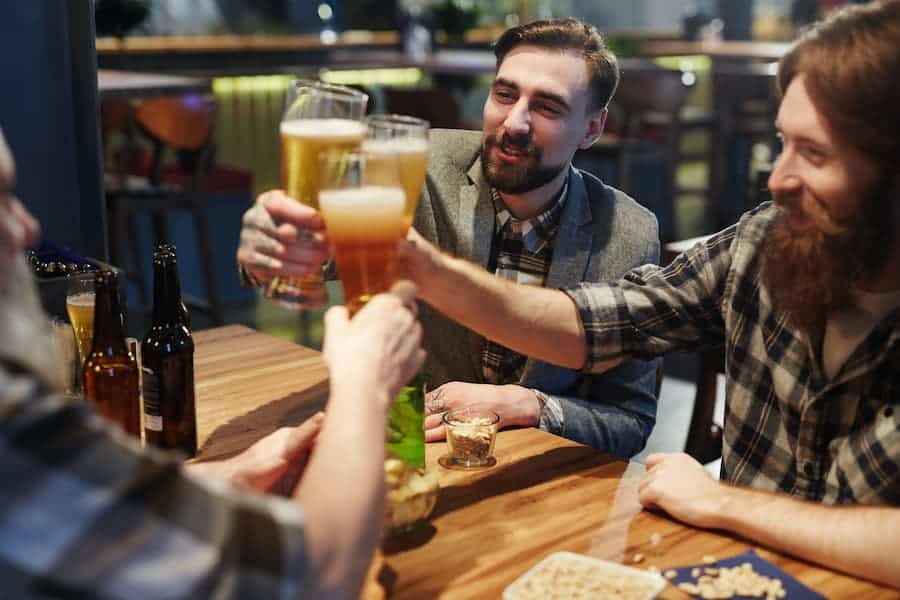If you buy something through a link in our posts, we may get a small share of the sale.
Many people see rating beer as an unnecessary process best left to nerds. However, rating can help you learn about beer or even train your palate. Learning how to rate beer can set you apart from the beginners and make you look like a true connoisseur.
Contents
How to Rate Beer
When it comes to rating beer, there are many factors to consider. Some people might be more interested in the taste, while others might focus on the appearance or aroma. However, it’s advisable to rate the beer professionally using all the aspects.

Rating Beer Professionally
Rating beer involves considering its faults and characteristics. Besides, there are many qualities that you should pay attention to in order to rate beer accurately, ensuring that you create a level field for all brewers.
Appearance
Have a look at your beer and describe its head retention, color, lacing, and clarity. For instance, if the color of the beer is brown, black, golden, pale, or amber. Check whether the head retention of the beer is lackluster, creamy, inviting, lively, or foamy.
You can also check whether the beer is cloudy, clear, turbid, or hazy. Many people think that this is not important, however appearance sets your expectations and is often a sign of bad or good things to come. Pour your beer into a clean, clear glass and raise it to eye level for better viewing.
Taste
Taste your beer and describe any fermentation by-products, finish or aftertaste, malt, balance, hops, and other flavor characteristics. Considering that flavor descriptions will frequently be the same as the smell, ask yourself how well does it fit the guidelines of style and whether there is a specific flavor or dominating ingredient, or is it balanced?
Important Taste Tips:
- Do you get any flavor that reminds you of a certain food or thing? If any, note it.
- Sip, allow it to warm and wander on the roof of your mouth, swallow and then breathe out. This process of breathing out is known as retro-olfaction. It releases stimulations retained at the mouth level and mucus at a high temperature.
- Tasting the beer after it warms up can allow more flavors to materialize and get easily recognized.

Aroma (Smell)
Hops are the key components of a beer’s aroma and flavor. They help beer retain its freshness and head of foam. When rating beer you should smell it and describe any yeast, malt, hops, and other aromatics.
For example, you should be able to tell whether the alcohol is spicy, boozy or peppery.
Whether the malt aroma is chocolate, roast, caramel, sweet, nutty, bread, biscuits, smoky, toasty or toffee. If it’s hops, you should tell whether the aroma is grassy, citrusy, herbal, resiny, piney, grapefruit, dank, leafy, floral, perfumy or leafy. Keep in mind that yeast also has a great effect on the production of aroma in beer.
They also add a fruity flavor in beer, making it more tastier. You should tell whether the ale’s yeast is peppery phenols or spicy, flowery, or fruity esters and whether the wild yeast /bacteria is horse blanket, funk, band-aids, barnyard, or medicinal.
Tips:
- Draw breath through your nose, then with your mouth open. There is a connection between the mouth and nose in the experience. This process is known as olfaction.
- Stir your beer by lightly swirling it in a frosted glass. These test the head retention, pull out slight nuances, aromas, loosens, and stimulate carbonation.
Mouthfeel (Feel)
Drink the beer and while in the mouth, describe its body, carbonation, astringency, warmth, creaminess, and other sensations in the roof of your mouth. Essentially, you should be able to describe how the beer feels while in the mouth. Whether it leaves a bitter taste or a crisp finish in your mouth.
For instance, whether the beer feels light, raw, thin, coarse, heavy, watery, chewy, or oily. Additionally, the beer might be over-carbonated, flat, crisp or seltzer-like. You may roll another sip in your mouth and allow it to wander. Focus on the beer’s texture on the roof of your mouth in order to clearly understand its feel.
Overall Enjoyment
After evaluating everything from appearance, taste, aroma and mouthfeel, rate the overall enjoyment. For instance: Was the beer delightful? Did it meet or exceed your expectations?
Be Incase of any flaws, be constructive and sincere as you provide proposals for improvement.

Other Considerations
Even when rating beer, here are a few other things you should consider as they might influence the beer’s rating.
Generate Personal Opinion
Ensuring that others do not influence you when rating beer is crucial. Everybody has a different experience with different beer styles, so ensure you’re based on your own opinions.
Respect Beer and Brewers
Behind every beer is a brewer with pride and emotions. Brewing may be their livelihood, passion, or whole life. Even if you don’t love a certain beer style, have some courtesy and mind how you criticize the brewer.
Keep Style in Mind
No one expects you to rate like an expert, however, if you keep the beer style in mind, you will approach every beer a bit more accurately. Review objectively and rate the beer for what it attempts to be and not what you think it should be.
Don’t rate beer styles that you don’t love as your opinion will be biased. You may not like a certain beer characteristic, probably because of its style, nevertheless you should not describe it as faulty. Before rating your beer, it is essential to learn about beer style guidelines from the Beer Judgment Certification Program (BJCP).
Use Clean Glassware
It is crucial to use a clean glass when rating. The kind of glass you also use significantly affects your entire experience.
Clean the Roof of Your Mouth
It’s advisable to have a glass of water and plain bread with you to help clean the roof of your mouth between beers. Avoid taking salty and greasy foods or anything that can overpower your senses, for your aim is to clean your palate.
What to Avoid When Rating Beer
When rating beer, avoid the following things as they might affect how you perceive it rather than feeling the taste and describing it.
Don’t Rate From Memory
There’s no need to rate every beer that you take. However, if you must, write down notes rather than trying to recall a beer experience from years, months, weeks, or days.
Don’t Rate Bad Beers
It is advisable not to rate bad beers, because they are bad for reasons the brewer cannot control. It’s advisable to alert the person you bought it from, who in turn notifies the brewer.
Frequently Asked Questions
What Does BA Score Beer Mean?
The BeerAdvocate (BA) score is the overall score of beer based on its position within its style category. It focuses on the beer’s trimmed mean and a custom rank relating to Bayes’ theorem.
How Does Beer Rating Work?
You create a users rating on a combination of scales that add up to 50 points. You then divide the rating to get a five-point scale rating, where every beer gets a weighted average of the 5-point scale rating. In this case, you base a beer score on its percentile rank among all beers.
Final Thoughts
When rating beer, it’s not to anyone’s expectation that you will rate it like a pro. Sharing your beer experiences should be fun and ensure you rate your overall enjoyment. Experiment with different tastes and aromas until you train your mouth on how to rate beer and clearly describe it using your senses.

